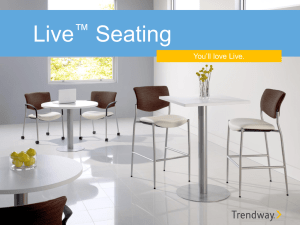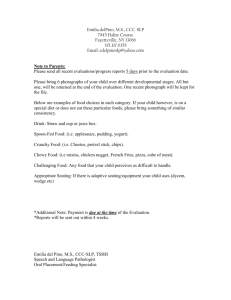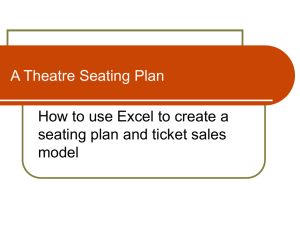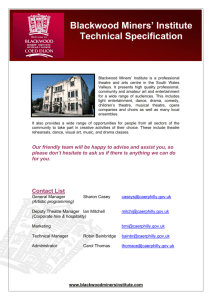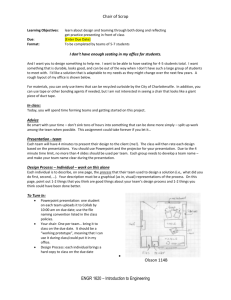ART B 6 important tips staging lighting
advertisement
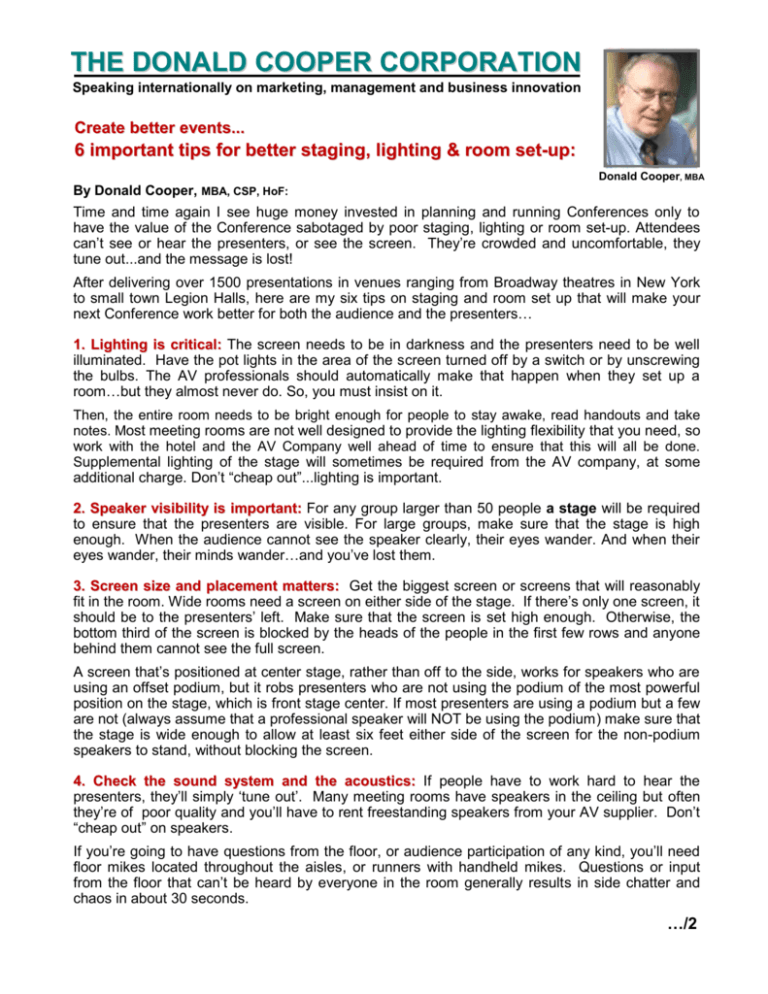
THE DONALD COOPER CORPORATION Speaking internationally on marketing, management and business innovation Create better events... 6 important tips for better staging, lighting & room set-up: Donald Cooper, MBA By Donald Cooper, MBA, CSP, HoF: Time and time again I see huge money invested in planning and running Conferences only to have the value of the Conference sabotaged by poor staging, lighting or room set-up. Attendees can’t see or hear the presenters, or see the screen. They’re crowded and uncomfortable, they tune out...and the message is lost! After delivering over 1500 presentations in venues ranging from Broadway theatres in New York to small town Legion Halls, here are my six tips on staging and room set up that will make your next Conference work better for both the audience and the presenters… 1. Lighting is critical: The screen needs to be in darkness and the presenters need to be well illuminated. Have the pot lights in the area of the screen turned off by a switch or by unscrewing the bulbs. The AV professionals should automatically make that happen when they set up a room…but they almost never do. So, you must insist on it. Then, the entire room needs to be bright enough for people to stay awake, read handouts and take notes. Most meeting rooms are not well designed to provide the lighting flexibility that you need, so work with the hotel and the AV Company well ahead of time to ensure that this will all be done. Supplemental lighting of the stage will sometimes be required from the AV company, at some additional charge. Don’t “cheap out”...lighting is important. 2. Speaker visibility is important: For any group larger than 50 people a stage will be required to ensure that the presenters are visible. For large groups, make sure that the stage is high enough. When the audience cannot see the speaker clearly, their eyes wander. And when their eyes wander, their minds wander…and you’ve lost them. 3. Screen size and placement matters: Get the biggest screen or screens that will reasonably fit in the room. Wide rooms need a screen on either side of the stage. If there’s only one screen, it should be to the presenters’ left. Make sure that the screen is set high enough. Otherwise, the bottom third of the screen is blocked by the heads of the people in the first few rows and anyone behind them cannot see the full screen. A screen that’s positioned at center stage, rather than off to the side, works for speakers who are using an offset podium, but it robs presenters who are not using the podium of the most powerful position on the stage, which is front stage center. If most presenters are using a podium but a few are not (always assume that a professional speaker will NOT be using the podium) make sure that the stage is wide enough to allow at least six feet either side of the screen for the non-podium speakers to stand, without blocking the screen. 4. Check the sound system and the acoustics: If people have to work hard to hear the presenters, they’ll simply ‘tune out’. Many meeting rooms have speakers in the ceiling but often they’re of poor quality and you’ll have to rent freestanding speakers from your AV supplier. Don’t “cheap out” on speakers. If you’re going to have questions from the floor, or audience participation of any kind, you’ll need floor mikes located throughout the aisles, or runners with handheld mikes. Questions or input from the floor that can’t be heard by everyone in the room generally results in side chatter and chaos in about 30 seconds. …/2 6 Staging and room set-up tips… cont’d: Page 2 of 2: 5. The right seating arrangement is critical to the success of your meeting: By far the most effective seating arrangement for most conferences is “classroom style” which gives everyone a writing surface and more space to lean, change positions and keep comfortable. There’s always water available and often candies or jelly beans. If you want to spoil your audience, buy them Werther’s caramels or M&M’s and have the hotel put two dishes of them on each table. Next best, after classroom seating, is “half rounds”. The tables themselves are “full rounds” but you can only put people at the back side of each table so that everyone is more or less facing the stage. This means that a maximum of 4 people can be seated properly at most round tables. The result is that you need a much bigger room to accommodate your group. Don’t let hotel sales people tell you that you can easily put 5, 6 or 7 people at a round table. It simply doesn’t work. “Half rounds” work best if you’re having small group discussions as part of the program and, of course, there’s lots of room to write and for water and treats. The least effective seating arrangement by far is “theatre style” where chairs are crammed together, there’s nowhere to take notes, except your lap and there’s no water or treats. Especially for any presentation longer than 40 minutes, unless the presentation is primarily entertainment, avoid “theatre style” like the plague. Not only does “classroom style” function better than theatre style seating, psychologically people are more prepared to learn when entering a “classroom” setting. We go to a classroom to learn…we go to the theatre to be entertained. When using classroom or theatre style seating in a wide room, gently curve the rows to make it easier for the folks to the far left and right to see the stage without having to turn and twist their bodies, which is hugely uncomfortable for long periods. Before you book a hotel for your conference, make sure that they have rooms big enough to accommodate a seating plan that works for your audience. If they tell you that you have to go with theatre style seating to fit everyone in, find another hotel with the room size you need to do it right. Whatever the type of seating, the first row should never be more than 6 to 8 feet from the front of the stage. More space than that creates an emotional pit into which much of the energy of the presentation falls and dies. For the same reason, when a room is wide, it’s best to have two offcenter aisles rather than one center aisle. Bonus seating tip: When setting up the room, tape off the back few rows with masking tape at both ends of the row. This accomplishes two important things… 1) First, it will encourage people to fill up the front seats, which creates a much better energy dynamic in the room. It’s more difficult to deliver a great speech when the first four rows are empty. The connection between the speaker and the audience is somehow broken and energy is lost. Don’t ask me to explain it scientifically...it’s just the way it works. 2) Second, if all the back seats are filled first, latecomers have to walk all the way up to the front during the speaker’s presentation, disrupting and distracting the audience. When the back few rows are left empty, the latecomers simply slip into a back row seat with no fuss and no disruption. Yes, proper staging and seating takes effort and may cost a bit more. But compared to the total cost of your conference, it’s insignificant. On the other hand, ineffective staging, lighting, sound and seating carries a very high cost…the cost of people missing all or part of the message. 6. While we’re at it, get the room temperature right: People can’t focus so well when the room temp. is uncomfortable. Just like Baby Bear’s porridge in the story of Goldilocks, the room needs to be not too hot and not too cold. It needs to be “just right”. Donald Cooper speaks & coaches internationally on marketing, management and business excellence. For more info on how Donald can be helpful, contact the wonderful Sharen Skene at sharen@donaldcooper.com or by phone in Toronto, Canada at 1-416-252-3704.

